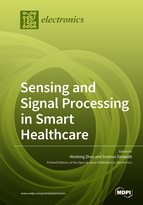Sensing and Signal Processing in Smart Healthcare
A special issue of Electronics (ISSN 2079-9292). This special issue belongs to the section "Computer Science & Engineering".
Deadline for manuscript submissions: closed (31 December 2019) | Viewed by 61038
Special Issue Editors
Interests: fault-tolerant computing; computer and network security; peer-to-peer and grid computing; performance evaluation of distributed systems
Special Issues, Collections and Topics in MDPI journals
Interests: cyber security; risk mitigation; emerging wireless technologies; mobile computing; applications of near field communications (NFC); radio frequency identification (RFID) systems, smartphones; sensor networks and body area networks
Special Issue Information
Dear Colleagues,
In the last decade, we have seen the rapid development of electronic technologies that are transforming our daily lives. Such technologies often integrate with various sensors that facilitate the collection of human motion and physiological data, and are equipped with wireless communication modules such as Bluetooth, RFID, and NFC. In this Special Issue we welcome contributions that report research and development towards a smarter healthcare based on various emerging sensing and communication techniques. In smart healthcare applications, designing ergonomic and intuitive human–computer interfaces is crucial, because a system that is not easy to use will create a huge obstacle to adoption and may significantly reduce the efficacy of the solution. Signal/data processing is another important consideration in smart healthcare applications because it must ensure high accuracy with a high confidence level in order for the applications to be useful for clinicians to take diagnosis and treatment decisions.
Prof. Dr. Wenbing Zhao
Prof. Dr. Srinivas Sampalli
Guest Editors
Manuscript Submission Information
Manuscripts should be submitted online at www.mdpi.com by registering and logging in to this website. Once you are registered, click here to go to the submission form. Manuscripts can be submitted until the deadline. All submissions that pass pre-check are peer-reviewed. Accepted papers will be published continuously in the journal (as soon as accepted) and will be listed together on the special issue website. Research articles, review articles as well as short communications are invited. For planned papers, a title and short abstract (about 100 words) can be sent to the Editorial Office for announcement on this website.
Submitted manuscripts should not have been published previously, nor be under consideration for publication elsewhere (except conference proceedings papers). All manuscripts are thoroughly refereed through a single-blind peer-review process. A guide for authors and other relevant information for submission of manuscripts is available on the Instructions for Authors page. Electronics is an international peer-reviewed open access semimonthly journal published by MDPI.
Please visit the Instructions for Authors page before submitting a manuscript. The Article Processing Charge (APC) for publication in this open access journal is 2400 CHF (Swiss Francs). Submitted papers should be well formatted and use good English. Authors may use MDPI's English editing service prior to publication or during author revisions.
Keywords
- Sensing, signal processing
- machine learning
- human–computer interaction
- NFC
- Bluetooth
- RFID
- computer vision
- image processing
- data analytics for healthcare
- healthcare user studies







